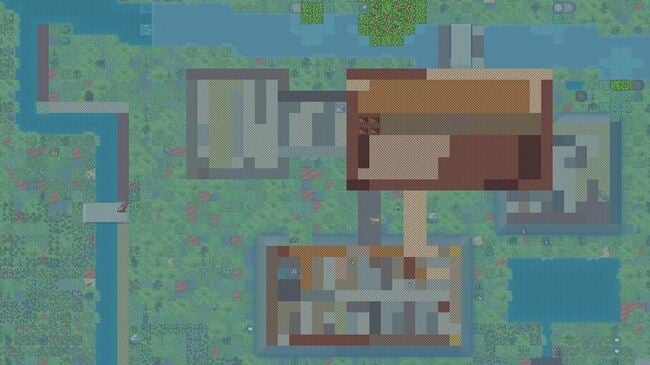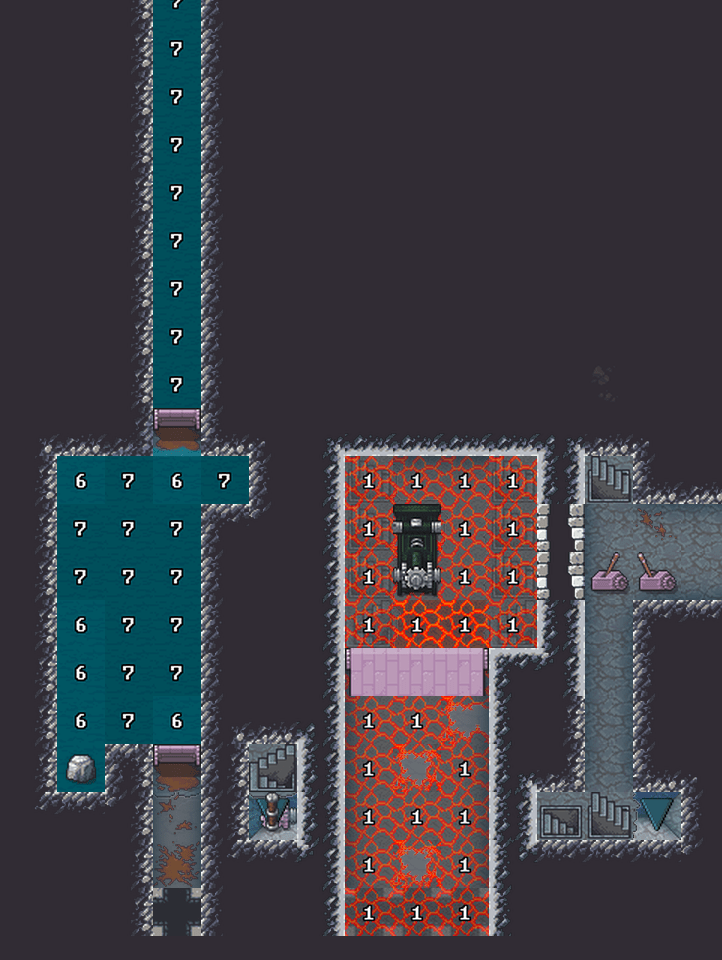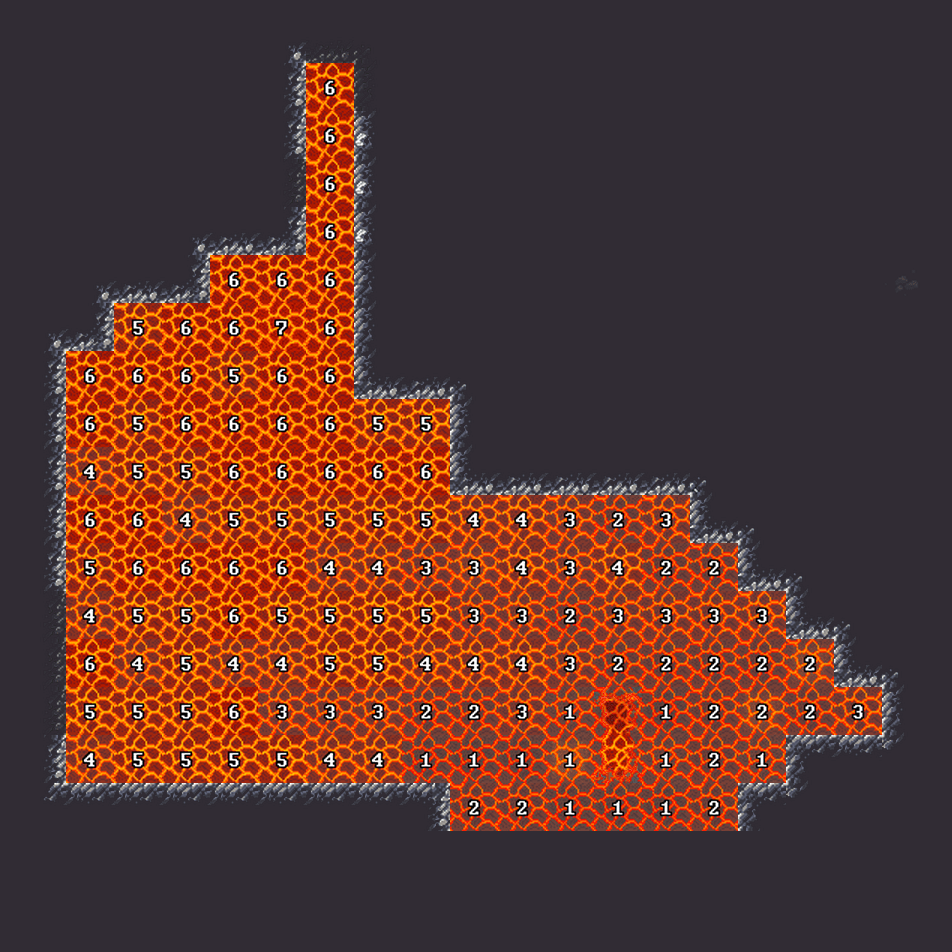Table of Contents Show
This is a guide to pumping magma to the surface and making artificial eruptions of lava.
This guide assumes at least an intermediate understanding of game mechanics.
Magma: A diplomatic solution to sieges.
Goblin sieges can be a bloody and messy affair, what with the corpses and severed limbs and blood everywhere. But what if the goblins could be convinced to drop their most valuable goblinite and disappear in a puff of smoke?
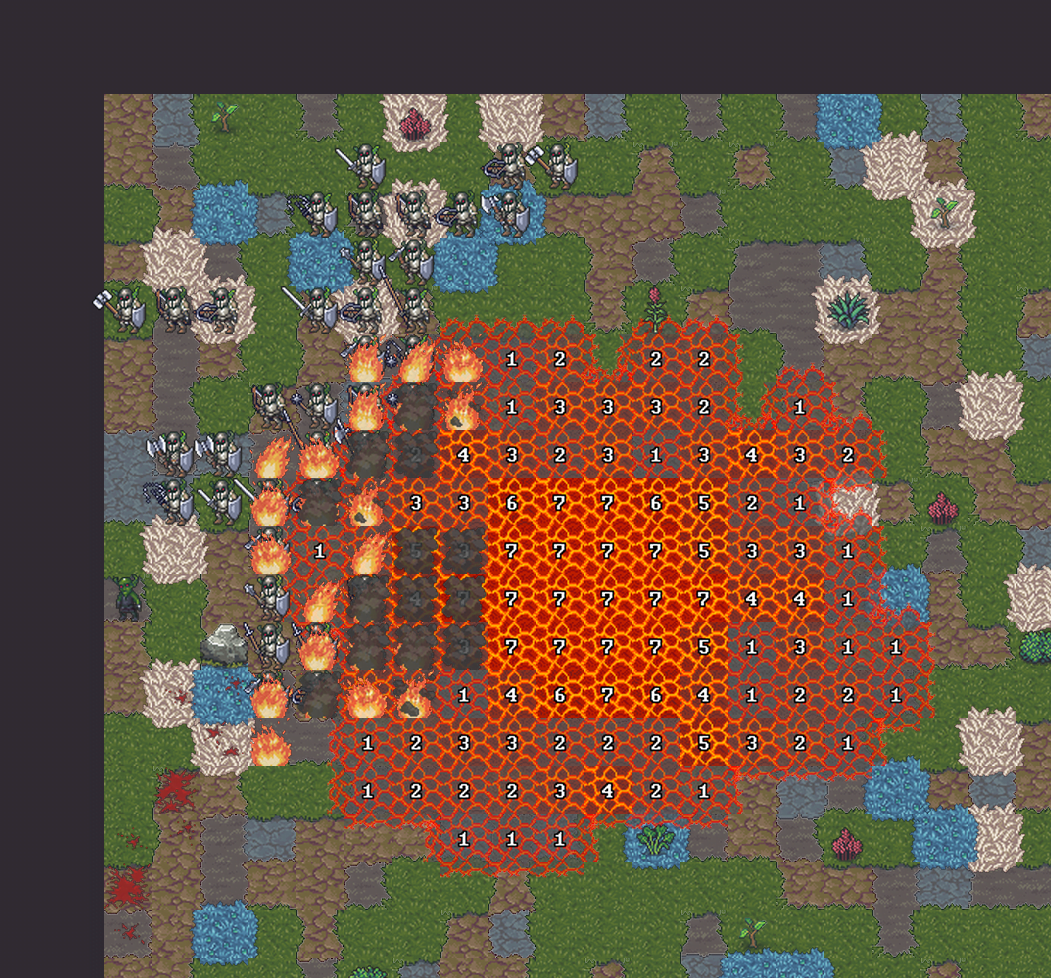 Magma, the diplomatic solution to goblins asking for your stuff!
Magma, the diplomatic solution to goblins asking for your stuff!
Yes, I think we can agree that would be better for everyone. With the help of this guide and some dwarven ingenuity you too can solve your goblin problems with an explosive outpouring of the Blood of the Mountains.
But first a disclaimer: there’s a lot of tricky dwarvern engineering which goes into such a megaproject, I’m not going to explain everything step-by-step, like if you totally don’t know what a pump stack is or how to make one, look it up on the wiki and get some basic experience pumping slightly safer things like water. I’ll be covering the major components used and some tricks and shortcuts I use but it’s not practical to explain exactly how to build such a large contraption.
Worldgen and embark
Under normal worldgen settings the magma can be very deep under ground. While it’s totally possible to build a pump stack that deep it’s really just hurting your fps and increasing the tedium of the build. I normally use worlds with only 1 cavern layer.
The other thing is choosing a relatively small and flat embark. It just makes the surface plumbing simpler. The screenshots from this guide are a 2×2, totally flat embark.
It’s worth noting these are fairly normal settings I play with even when not pumping magma to the surface, I prefer shallower and smaller embarks.
The “Flowing Water Reactor”
We’re going to need a lot of power to pump magma to the surface. There is one power source which is absolutely superior, with basically no fps impact: the flowing water reactor. When pressurized water flows off the map edge (or into a heavy aquifer) the game flags it as flowing causing it to power waterwheels even when at 7/7 depth (pressurized water is that which is produced by a screw pump, or that which has descended at least 1 z-level into 7/7 water).
To power my magma pump stack I have 6 water wheels:
The wheels are above a patch of water that is flagged as flowing:
The water source is the to the north, at the south is an edge-of-map drain
I made a side-of-the-map drain by smoothing and carving fortification slits, set up a pair of raising bridges (or flood gates) linked to a lever to cut off water movement, and tapped the cavern lakes several z-levels above the reactor via smoothing and carving fortifications. You actually can just let the water keep flowing off the map when using an infinite source like the cavern lakes, but if you want to minimize fps hit, cut off the actual water movement, suspend your disbelief and save some CPU cycles.
I normally make my reactor very near the base of the pump stack, but in principle you can have it anywhere up the stack as long as you have a source of water.
And you can of course, use windmills if the map supports it.
Securely passing power through a wall
There are three ways of transmitting power: axles, mechanisms and screw pumps (or other machines). An axle consumes 1 power per tile, a mechanism consumes 5 power and a screw pump consumes 10 power.
The output side of a screw pump counts as a wall for blocking liquids, so a screw pump can be used to pass power through a wall without liquid leaking through, just take care that the pump inlet is blocked by a floor or wall so it only transmits power and not water.
This screw pump will never pump anything, it simply serves to transmit power through the wall.
When power has to be transmitted through magma, a magma-safe mechanism is a safe solution, but in principle a nether-cap axle should do the trick too.
You should include plenty of levers for shutting things down, and linking a lever to a mechanism is a great power-shutoff.
Open Shaft Pump Stack
I use a non-typical open shaft pump stack design which is fast to designate, in the wiki design each level of the pump stack has a cute little personal reservoir, while an open shaft design exploits the fact that screw pumps move liquid faster than it falls under gravity, essentially each level of the stack just grabs the liquid out of the air before it can fall.
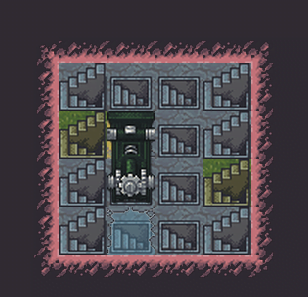
A typical level of the pump stack. Note the lack of reservoirs.
Note that when I say “open”, I generally include stairs as open space: up/down and down stairs are totally transparent to liquid with the only exception being that a pump stack can’t pull liquid up through a down stairs. So for the most part stairs are open space for the purposes of liquid movement, but provide a place for dwarves to stand and act as anchors for constructions and machinery, and having stairs wherever possible dramatically reduces the risk of dwarves falling.
- Dig out a shaft which is at least 3×4 but can be larger, dig the shaft out using up/down stairs as they are just as transparent to liquid as channeling, but much safer for dwarves.
- Smooth any aquifer walls or replace with constructed tiles.
- Remove the upstairs from only the center tiles where you intend to build the pumps, leave the up/down stairs on the sides for dwarves to use.
- Channel out the pump inlet tile and power transmission tile, these are separated by 1 tile, and alternate every z-level, this is the basic “head over tail” pumpstack. This has to be done manually or with a macro for all z-levels.
- Note that a hanging screw pump can be built directly on downstairs, “hanging” means “supported by another machine rather than a solid foundation”, to build a screw pump “access” is required, that just means the dwarf needs to be able to stand on the walkable tile while building it.
- Designate the screw pumps, you either have to start building from the bottom, or build a mechanism or nether-cap axle on the stairs that will anchor an adjacent “hanging” screw pump. Including extra anchors at various points up the stack isn’t an altogether bad idea, as if a dwarf loses their construction materials the whole stack of pump designations can be cancelled or deconstructed.
- I make my screw pumps and tube sections out of green glass, if you don’t have sand, then iron is a reasonable alternative. The blocks are any magma-safe stone. IIRC in a traditional pump stack you can use merely fire-safe materials, but for an open shaft pump stack you want fully magma safe materials since magma gets everywhere.
Magma Feeder Pumps
In my experience often the major limiting factor of pumpstack throughput is not the amount of magma that the pump stack can move, but how quickly magma can flow to the bottom pump, if you just suck from a random point in the magma sea the natural flow of magma will be a bottleneck.
For this reason I suck magma directly from the map edge where it is almost instantly replenished, using a battery of screw pumps, force-feeding the pump stack.
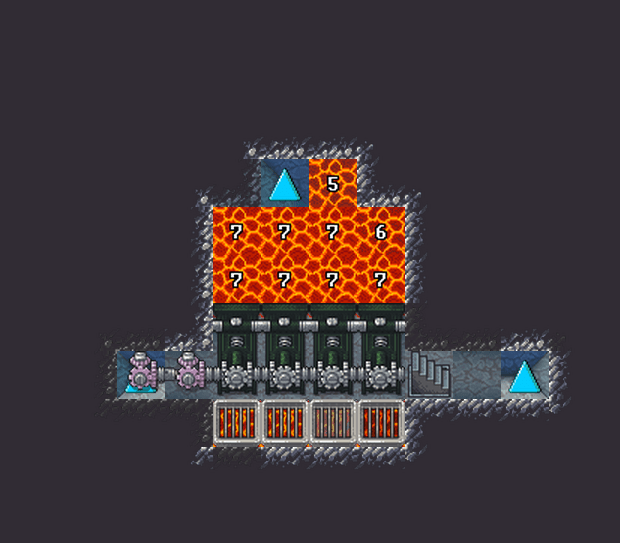
The feeder screw pumps are built as close to the map edge as the game allows
I also like to pull from a little “magma pocket” instead of disturbing the larger magma sea, though this is probably mostly perfectionism rather than actually useful. An artificial pocket can be made by casting obsidian, but in this game I had a natural pocket.
Under the screw pumps, pulling from the map edge.
Surface magma cistern and the mechanics of magma pressurization
To make an artificial volcano or magma land mine that erupts with actual violence, you need to pressurize magma with screw pumps, magma pumped by a screw pump will teleport through 7/7 magma (excluding diagonals) and erupt at an opening. The pressurized magma can only rise as high as the screw pump outlets, what this practically means is you need to extend the pump stack up into the sky a few z-levels and build a magma cistern above the ground.
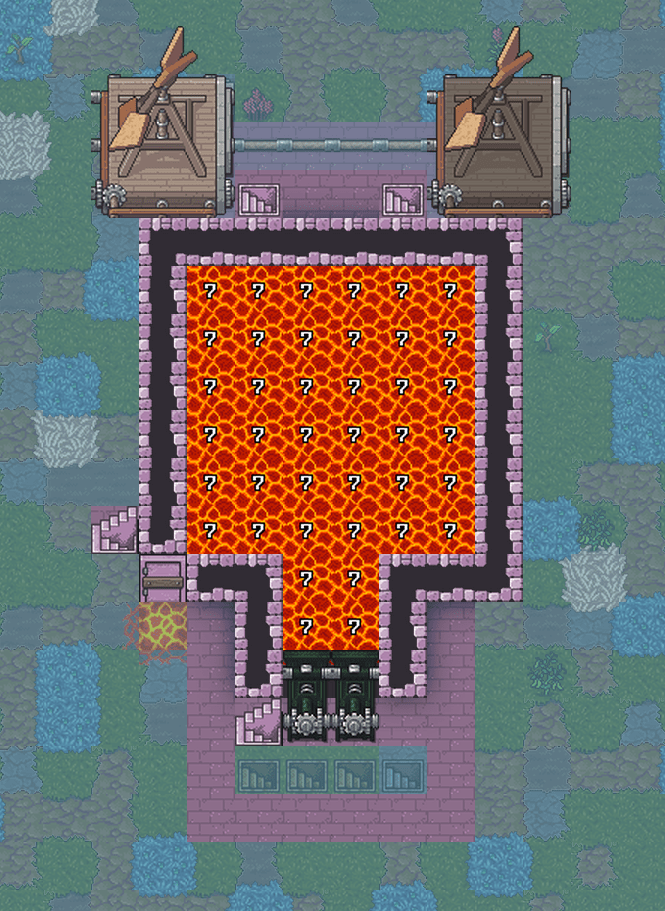
The magma cistern extends 3 z-levels above the ground
To achieve an eruption of maximum violence, you want to have multiple screw pumps pressurizing the magma, and you also want those screw pumps to be have a healthy supply of magma on the inlet side: this is best achieved by having the cistern extend multiple z-levels above the screw pumps so magma falls down into the pump inlets, this can create a truly violent eruption for several seconds, until gravity has fed most the magma into the pumps.
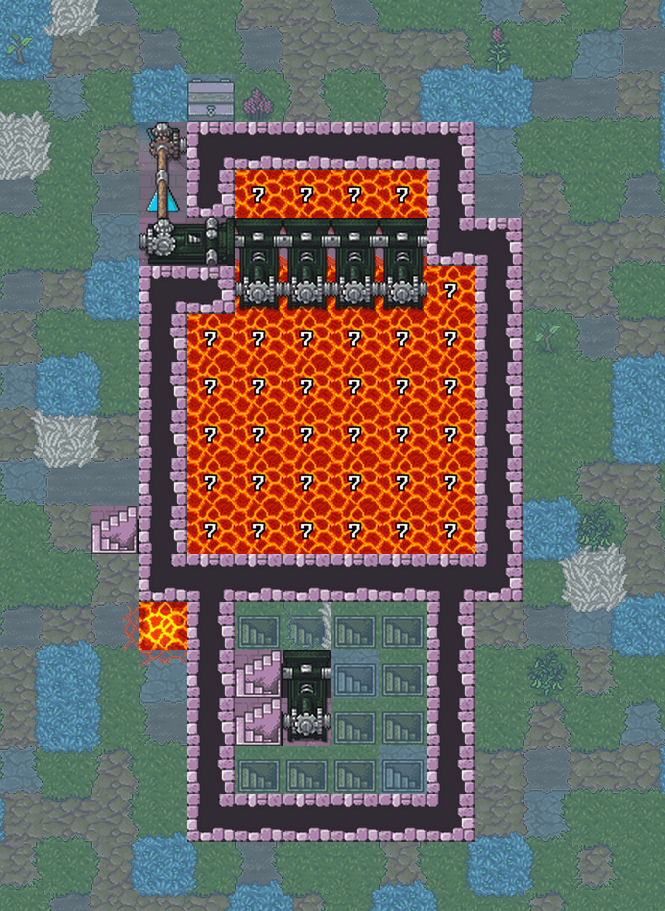
The pressurization pumps 1 z-level above the ground
Essentially the violence of the eruption is a combination of how many screw pumps you use to pressurize, and how many z-levels of magma are above the screw pumps. I used 4 screw pumps, that pull from 4 z-levels of magma.
On this map I decided to power the 4 pressurizing screw pumps using a pair of Wind Mills, this is mainly because I want to turn the pump stack off by disconnecting a mechanism once the magma cistern is full, but I want the pressurizing pumps to run all the time, so the pump stack can’t be relied on to transmit power. (Note: Windmills can be built totally hanging in the air, as long as they are adjacent to a machine, I placed them in a way aesthetically pleasing to me.)
It if pleases you, you can try to use a pressure plate in the cistern set to magma level so the pump stack automatically turns off once the cistern is full.
Magma Land Mines as a practical defense
The Magma Land Mine is comparable to the nuclear land mine: an explosive upwelling of destruction that vaporizes everything in the vicinity. But like nuclear weapons, magma weapons suffer from rapidly diminishing returns in terms of destructive radius from making them more powerful, hence the use of MIRV weapons that hit targets of interest with smaller explosions instead of trying to destroy everything with a single massive explosion.
The basic principle of magma land mines is to feed the pressurized magma down into an underground system of shafts and tunnels that distribute the pressurized magma. (If you use above ground aqueducts to drop magma bombs it’s instead an orbital magma cannon)
Under the ground a system of magma tunnels supply the magma land mines.
It would be most intuitive to release the magma by opening a hatch, and that does work fine as long as you’re willing to let building destroyers destructively trigger the land mine, which is hilarious. But I prefer to use a door on the z-level below, such a door cannot be targeted by building destroyers and has no opening delay when a linked lever is pulled. Of course there are many ways you can setup the magma flow control, including the use of underground hatches.
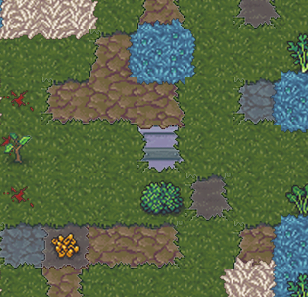
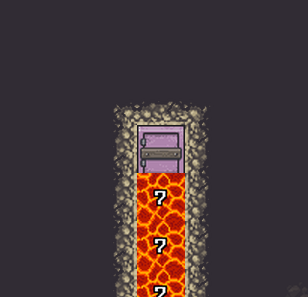
A door with the floor above it mined out serves to block magma until the linked lever is pulled.
To be more secure instead of channeling out the floor, you can dig out downstairs, or you can build floor bars/grates over the hole to stop debris falling down the hole: of course, the magma would melt the vast majority of debris that fall down the hole.
The Lever Room
It’s hard to remember what all the different levers do, and while it certainly helps to label levers with their function, for the specific purpose of setting off magma land mines on the surface, it really makes sense to have a room that mirrors the surface with the levers matching the position of the land mines:
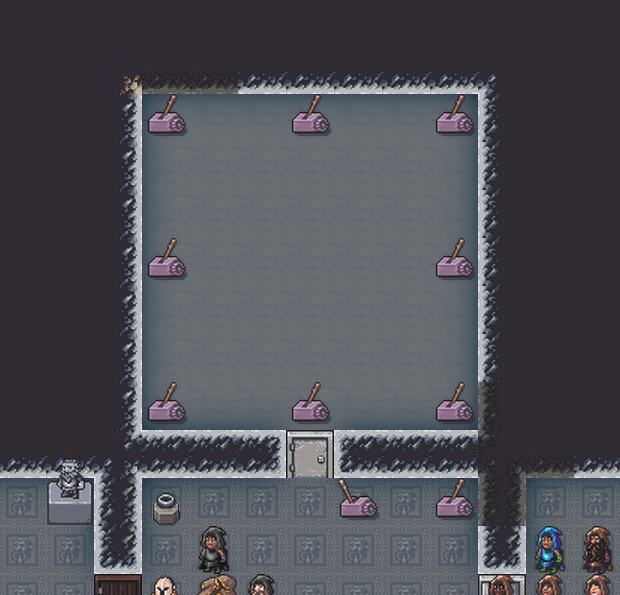
Hence when the goblins come to parley, the lookout can just scream down the shaft “Hey Urist! Goblins want to parley at 10:30!” and Urist knows exactly which lever to pull to send the appropriate diplomatic response.
And while the Goblins are screaming back: “No! We want to parley now you hairy fools!” they get engulfed in surprise fiery goodness. Isn’t !!negotiations!! a wonderful process?
Automated Landmines
It’s also possible, though perhaps not advisable, to make automated landmines that trigger when enemies come near. For this you basically make a tower with underground access via up/down stairs, inside the tower is a male dog or another non-grazer animal that won’t pop out babies, assigned to a single-tile pen zone on a pressure plate set to be triggered by the animal, that holds the land mine shut (e.g. by making a raising bridge stay in the liquid-blocking “wall” position), the dog should have clear visibility of the land mine area through windows, when the dog sees approaching enemies it will panic or become excited and leave the 1×1 pen, releasing the pressure plate, lowering the raising bridge and triggering the magma eruption.
A dwarf will round up the dog and put it back on the pen, raising the bridge and shutting off the magma.
This is inadvisable as it’s highly likely to get triggered by random unimportant enemies like wild animals, causing hapless dwarves fooling around on the surface to get purified by fire.
But as the old dwarvern saying goes “Just because you can, is a good enough reason for a dwarf!”
